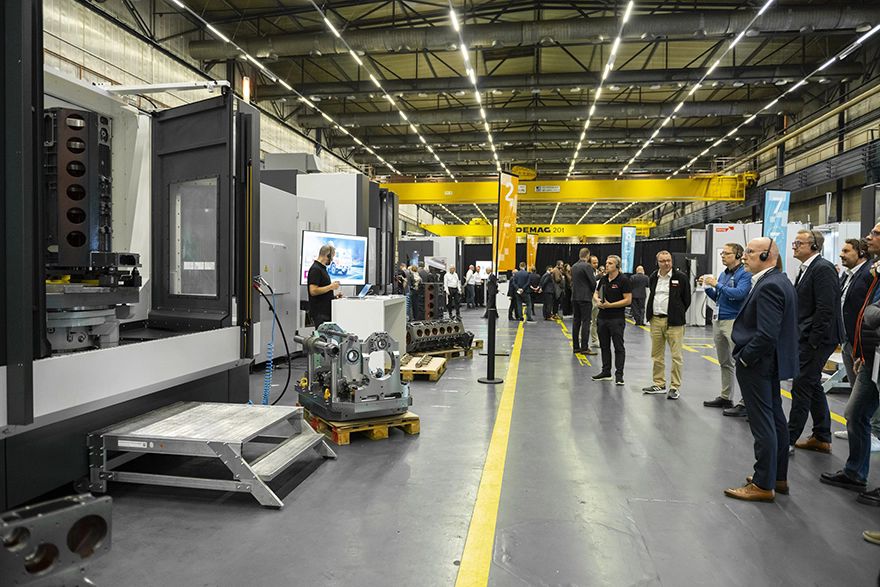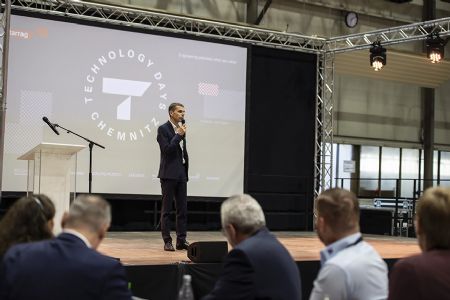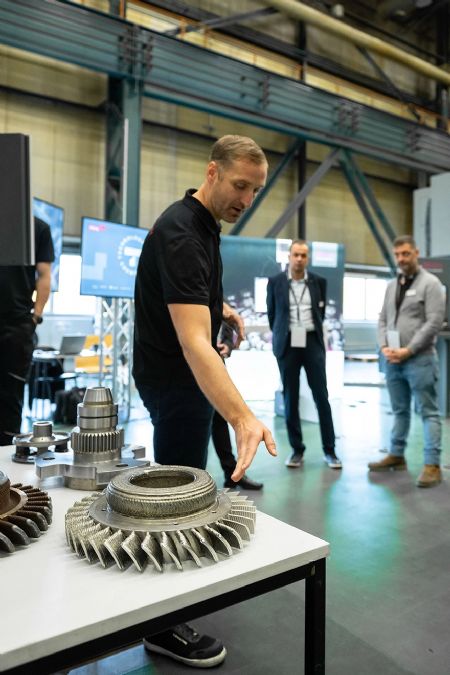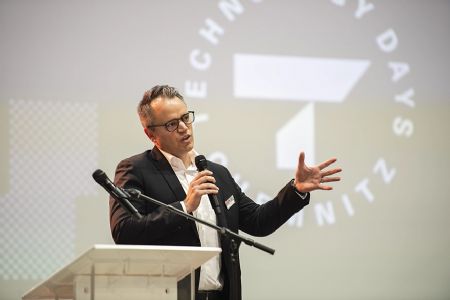 The participants were split into small groups to hold deeply informative discussions at the technology stations
The participants were split into small groups to hold deeply informative discussions at the technology stationsHigh precision, automation, and digital technology — this is what the future of metalworking looks like. During its recent
Technology Days event in Chemnitz,
Starrag showcased crucial building blocks and unveiled machine developments such as the new Heckert H100 compact machining centre. A sneak preview of the new large machine series that made its premiere was presented alongside perfectly coordinated peripherals.
The event also offered visitors a glimpse of the newly designed production hall, where precision-critical components for a wide range of
StarragTornos Group machines are manufactured in a highly automated process with micron accuracy.
Over 200 delegates filled the ‘reception hall’ for the two-day Starrag Technology Days in Chemnitz, including representatives from over 100 customers across eight different countries. The machining specialists at the Chemnitz facility selected four main topics to present their optimised manufacturing processes, working closely with peripheral suppliers Blum Novotest, Fanuc, Fastems, Gefertec, Haimer, HandlingTech, Pimpel, and Siemens.
 Pictured right: Martin Buyle, CEO of the StarragTornos Group, welcomed guests to the Technology Days in Chemnitz
Pictured right: Martin Buyle, CEO of the StarragTornos Group, welcomed guests to the Technology Days in ChemnitzThe first topic, ‘Small dimensions – big impact’, focused on the brand new Heckert H100 four-axis machining centre, which rounds off the top end of the current Heckert compact series. It was demonstrated with a pilot application developed for the Czech vehicle manufacturer
Tatra Trucks, where entire V8 and V12 engines are machined in five operations. Starrag application technologist Rico Ullrich explained: “Using a compact machine for such large parts saves a lot of money — in terms of machine investment, transport, foundations and installation space, right through to the machining process itself. Moreover, we also supplied the process design and developed the four required devices — all in close collaboration with the customer.”
The second topic, ‘The symbiosis of metal 3-D printing and five-axis finish machining’, holds great potential for the future. This was presented in the form of a Gefertec arc80X and a Heckert X50 with turning function. Kai Bohle, director of sales T&I at the company’s Chemnitz site, said: “In complex components, the generative process often saves more than 70% of raw material. This reduces the amount of finishing work required, meaning more parts of better quality can be machined in the same time than with conventional methods. While it is still niche at the moment, that will change.”
Tried-and-tested kinematicsFor the third topic ‘Innovation meets tradition’, Starrag presented a large, unclad machine — a sneak preview of the completely new generation of large machines, that will supersede the successful Heckert Large series. Importantly, users will be able to adopt fixtures and NC programmes from existing models as the tried-and-tested kinematics have been retained.
Product manager Carsten Bergmann said: “We have completely redesigned all frame components — beds, columns, and further optimised the machine, particularly with regard to thermal symmetry and chip disposal, and have managed to reduce the footprint by around 20%.” Even more rigid structural components and ball screws also allow higher cutting values to be realised, which contributes to reduced machining times.
 Pictured left: the symbiosis of metal 3-D printing and five-axis finish machining offers great potential for savings
Pictured left: the symbiosis of metal 3-D printing and five-axis finish machining offers great potential for savingsThe new large machines are designed as a modular system with four predefined sizes, two of which will be launched in 2025 and the other two through 2026 and 2027. A new module has already been presented on the basic machine, a matrix magazine with space for up to 828 tools.
The fourth topic was ‘Self-made precision’. Mr Bohle, said: “Our goal is to manufacture all precision-critical parts ourselves. That is why we are massively expanding production here at this site.”
Central to this are three Heckert HEC 800 X5 with turning function, which feature the Heckert High-Precision Package in addition to the optional extended travel paths. They manufacture pallets and faceplates for B axes and rotary drive units, bearing blocks, gearbox housings and more — fully automated in small and medium series. One important automation element is a Fastems linear storage system with 64 pallet spaces and two set-up stations.
However, the
Technology Days focused less on the Heckert HEC 800 machines manufactured in Chemnitz and more on the actual machining processes. Using the example of pallet machining, Starrag technologist Jan Wilske explained why precision is so important and what requirements must be met on the machine side. Using measurement logs, he impressively demonstrated that tolerances in the single-digit micron range are maintained across all batch sizes — in terms of the evenness, squareness, straightness of the contact surfaces and positions.
Precision-critical large partsA huge concrete foundation could be seen next to the Heckert HEC 800 machining centres. With an area of 22 x 14m, it provides the framework for the basic structure of a 12m Droop+Rein FOGS HD40 130 R50C high-gantry machining centre. With this huge high-speed machining centre from the Starrag site in Bielefeld, the Chemnitz-based company will in future machine all columns, machine beds and other precision-critical large parts for Heckert machines and other brands of the StarragTornos Group to an accuracy of just a few microns.
 Pictured right: Kai Bohle, director of sales T&I
Pictured right: Kai Bohle, director of sales T&IIn order to achieve not only precision but also the desired high productivity, it takes more than outstanding machines and peripherals. It is equally important that companies are well positioned in terms of digitalisation, a factor which Starrag fully buys into.
Accordingly, MDE and PDA systems were introduced in Chemnitz and Rorschacherberg and a detailed planning system was put into operation that supplies every workstation with daily data for optimised work processes — not only in production, but also in design, technology and project management.
At the
Technology Days, the themes of automation and digitalisation permeated all four of the event’s main topics. Starrag itself has a lot to offer in this regard, including digital services such as the online fingerprint and new HMI functions for web applications and camera integration. In addition, the British company
TTL, which belongs to the StarragTornos Group, presented its Virtual Machine (VM). This can ensure maximum process reliability in the Siemens NX world, even for demanding five-axis machining operations.
However, process optimisation and simulation using VM solutions and the digital twin were also recurrent themes at its partner booths at the event. The companies presented innovations from the fields of process-integrated measurement technology and robot automation. They explained the latest functionalities in CNC control systems and highlighted the benefits of an end-to-end digitalisation solution for tool clamping and presetting.